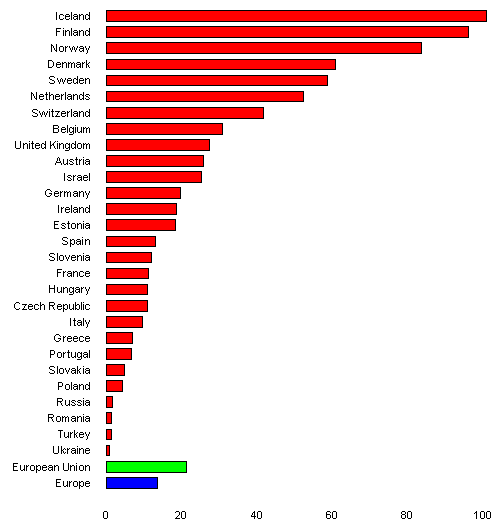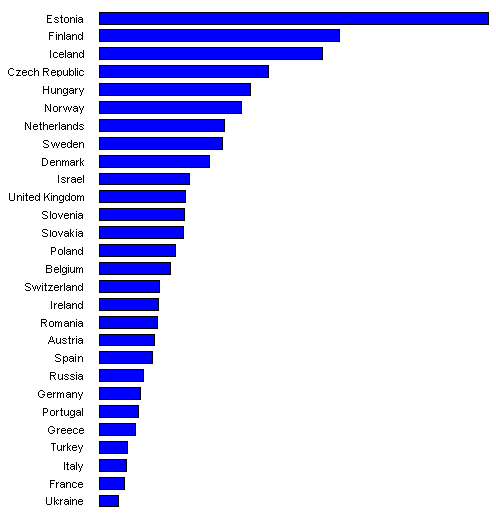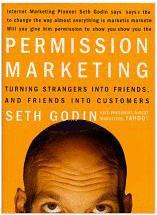|
There are no substantial changes; though Italy, and especially Spain, seem to be accelerating. It will take at least another three month to understand if this is a relevant trend. The second graph shows density (hosts per 1000 inhabitants) in 28 countries with over 20,000 internet hosts. Internet hosts per 1000 inhabitants (Countries in the RIPE area with over 20,000 internet hosts) – "adjusted" 1999 data
Scandinavian leadership remains, but the Netherlands are getting closer. Spain shows considerable improvement (and may benefit from fast growth in Latin America). The next graph, as usual, shows hostcount in relation to income (GNP). Internet hosts in relation to income (GNP)
As usual, Germany appears weak in relation to its economy, and several Eastern European countries are well placed. Here again we see improvement in Spain. France, if we don't consider the minitel, is as weak as Italy. ============================================ A somewhat whimsical worldwide hostcount update is offered by Netsizer. The real-time "counter" on this site is a fake, and quite meaningless. But they seem to be checking fairly frequently (though not daily). According to this source, there are over 63 million internet hosts and over 30 million web servers worldwide. ============================================ Some of the .com domains are outside the US. According to an analysis by Nic France, there are 263,194 .com domains in Europe. That doesn't change the hostcount picture significantly, especially when comparing countries; but for what it's worth let's see what happens if we add a standardized estimated number of hosts based on the .com domains – for the nine countries considered in the French analysis.
* The total includes all of the RIPE area but (as poointed out in the previous table) The figures look somewhat different if we consider this factor, but the relative positions of countries are essentially the same as in the basic hostcount analysis. Of course there are also European .net and .org domains, but the numbers are much smaller.
|
|
||
|
Seth Godin (vice president direct marketing – Yahoo) has written an interesting book on net marketing. He's a bit over-emphatic in promising to "show us the future", but many of his comments make sense. Like other recent books, such as The Caring Economy and High tech - High touch, it helps us to understand how network marketing and communication can be really effective if we care about relationships with people.
In Permission Marketing Seth Godin explains that corporate communication and marketing are in trouble. The traditional way, which he calls interruption marketing, has reached saturation. There are simply too many products, too many messages, for anyone to be able to pay attention. I think he overstates the point (traditional marketing isn't dead, it still works in many cases) but he is right in pointing to the new options offered by the internet. Even direct marketing and data based marketing, in the traditional sense, have serious limitations. The segmentation tools are clumsy, there is considerable (and growing) refusal. «These techniques – says Godin – are astonishingly wasteful.» Applying the same concepts in the internet isn't just wasteful; it can be harmful. This is what Seth Godin says about trying for "large numbers" on the internet. This is a very, very big haystack, and interruption
marketers don't have that many needles. People don't have the time to pay attention. The more bells and whistles are added to try to attract attention, the more they add to the clutter. The solution is to deal with people who are interested in what we have to say. This is how Seth Godin defines "permission marketing". Interruption Marketing is the enemy of anyone trying to
save time. By constantly interrupting what we are doing at
any given moment, the marketer who interrupts us not only
tends to fail at selling his product, but wastes our most
coveted commodity, time. In the long run, therefore,
Interruption Marketing is doomed as a mass marketing tool.
The cost to the consumer is just too high. There are two ways, Seth Godin says, of getting married. The Interruption Marketer buys an extremely expensive
suit. New shoes. Fashionable accessories. Then, working with
the best databases and marketing strategists, selects the
demographically ideal singles bar. Like all the best people writing about the internet, Godin is very critical of "dreaded" spamming. He is also against any violation of privacy and any attempt to capture, sell or buy personal data; which isn't only a waste – it's also a way of antagonizing people and destroying relationships before they can grow into binds of trust. He also talks about the advantages of opensource software. When there's an abundance of any commodity, the value of
that commodity plummets. If a commodity can be produced at
will and costs little or nothing to create, it's not likely
to be scarce, either. That's the situation with information
and services today. They're abundant and cheap. Information
on the web, for example, is plentiful and free. =================================== Seth Godin practices what he preaches – up to a point. On his website he offers, free of charge, the first four chapters of his book (and he is wise enough to send them as "plain text"). He promises: «I'll never rent or sell your email address.» (I would like to see more companies making that promise clearly and boldly). But... if you write to his mailbox you get a standardized and irrelevant automatic reply. That doesn't make his reasoning less interesting or valuable; but it shows that good management of interactive communication isn't quite as easy as he says.
|
List of links
For the convenience of readers that print the text before they read it, here is a list of the links.
Internet measurement and data analysis http://www.caida.org/Papers/Nac/
The cultivation of the internet http://gandalf.it/offline/off19_en.htm
Italians online http://gandalf.it/netmark/netmar37.htm#heading02
European data – February 1999 http://gandalf.it/netmark/netmar32.htm#heading04
European data – July 1999 http://gandalf.it/netmark/netmar36.htm#heading03
RIPE – Réseaux IP Européens http://www.ripe.net/statistics/hostcount.html
Latin America http://gandalf.it/netmark/netmar38.htm#heading03
Netsizer http://www.netsizer.com/daily.html
"Com" domains in Europe http://www.nic.fr/Statistiques/auto/Com/index.shtml
The Caring Economy http://gandalf.it/netmark/netmar36.htm#heading02
High tech - High touch http://gandalf.it/netmark/netmar32.htm#heading02
We can forget "segmentation" http://gandalf.it/offline/off17_en.htm
Permission marketing http://www.permission.com





